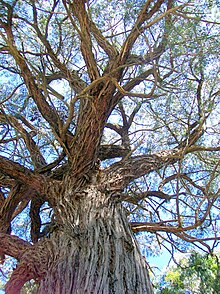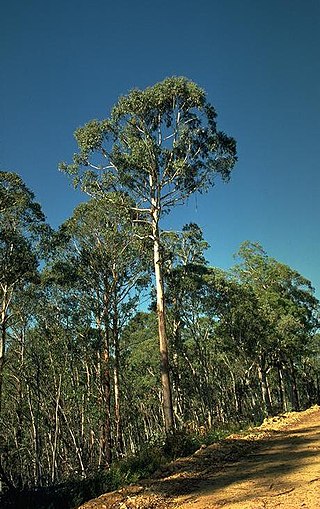
Eucalyptus delegatensis, commonly known as alpine ash, gum-topped stringybark, white-top and in Victoria as woollybutt, is a species of tree that is endemic to southeastern Australia. It has a straight trunk with rough, fibrous to stringy bark on the lower half of the trunk, smooth white bark above, lance-shaped to curved adult leaves, flower buds in groups of between seven and fifteen, white flowers and barrel-shaped or hemispherical fruit.

Eucalyptus dives, commonly known as the broad-leaved peppermint or blue peppermint, is a species of tree that is endemic to south-eastern Australia. It has rough, finely fibrous bark on the trunk and larger branches, smooth bark above, lance-shaped or curved adult leaves, flower buds in groups of eleven or more, white flowers and cup-shaped, hemispherical or conical fruit.

Eucalyptus polybractea, commonly known as the blue-leaved mallee or simply blue mallee, is a species of mallee that is endemic to south-eastern Australia. It has rough, fibrous or flaky bark on the lower part of the trunk, smooth greyish or brownish bark above, lance-shaped adult leaves, flower buds in groups of between seven and eleven, white flowers and cup-shaped or barrel-shaped fruit.

Eucalyptus capitellata, commonly known as brown stringybark, is a species of tree that is endemic to New South Wales. It is a small to medium-sized tree with rough, stringy bark from the trunk to the thinnest branches, lance-shaped to curved adult leaves, spindle-shaped or oblong flower buds in groups of seven or more, white flowers and clusters of flattened hemispherical fruit.

Eucalyptus caliginosa, commonly known as broad-leaved stringybark or New England stringybark, is a tree that is endemic to eastern Australia. It has stringy bark, lance-shaped or curved adult leaves, flower buds in groups of seven or nine, white flowers and more or less hemispherical fruit. It is common on the Northern Tablelands and North West Slopes of New South Wales and adjacent areas of Queensland.
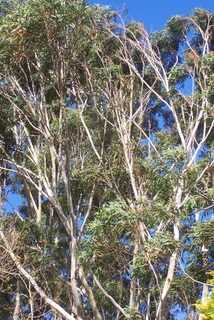
Eucalyptus pilularis, commonly known as blackbutt, is a species of medium-sized to tall tree that is endemic to eastern Australia. It has rough, finely fibrous greyish bark on the lower half of the trunk, smooth white, grey or cream-coloured bark above, lance-shaped to curved adult leaves, flower buds in groups of between seven and fifteen, white flowers and hemispherical or shortened spherical fruit.
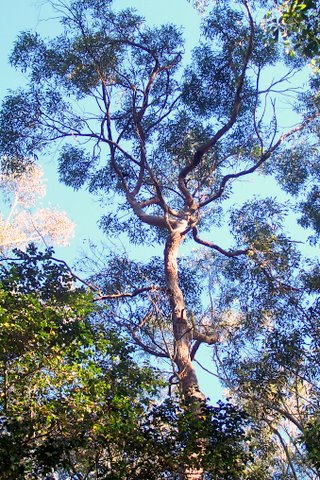
Eucalyptus resinifera, commonly known as red mahogany or red messmate, is a species of medium-sized to tall tree endemic to coastal areas of eastern Australia. It has rough, stringy or fibrous bark on the trunk and branches, lance-shaped adult leaves, flower buds in groups of between seven and eleven, white flowers and hemispherical, conical or cup-shaped fruit.

Eucalyptus laevopinea, commonly known as the silver top stringybark, is a tree that is endemic to eastern Australia. It has rough, stringy greyish bark on the trunk and larger branches, glossy green, lance-shaped adult leaves, flower buds in groups of between seven and eleven, white flowers and hemispherical or shortened spherical fruit.

Eucalyptus blaxlandii, commonly known as Blaxland's stringybark, is a tree that is endemic to south eastern New South Wales. It is a stringybark with lance-shaped adult leaves, flower buds arranged in group of nine or eleven, white flowers and hemispherical fruit.

Eucalyptus ligustrina, commonly known as the privet-leaved stringybark, is a species of shrub, mallee or small tree that is endemic to New South Wales. It has rough, stringy bark, lance-shaped to egg-shaped adult leaves, flower buds in groups of between seven and fifteen, white flowers and hemispherical or shortened spherical fruit.

Eucalyptus sparsifolia, commonly known as the narrow-leaved stringybark, is a tree endemic to New South Wales. It has grey to reddish brown, stringy bark, glossy green lance-shaped leaves, spindle-shaped flower buds and more or less spherical fruit.

Eucalyptus eugenioides, commonly known as the thin-leaved stringybark or white stringybark, is a species of tree endemic to eastern Australia. It is a small to medium-sized tree with rough stringy bark, lance-shaped to curved adult leaves, Flower buds in groups of between nine and fifteen, white flowers and hemispherical fruit.

Eucalyptus tenella, commonly known as narrow-leaved stringybark, is a species of small to medium-sized tree that is endemic to New South Wales. It has stringy bark, narrow lance-shaped to linear leaves, flower buds in group of seven to fifteen, white flowers and hemispherical fruit.

Eucalyptus cameronii, commonly known as the diehard stringybark is a flowering plant that is endemic to eastern Australia. It is a small to medium-sized tree with rough, stringy bark from the trunk to the small branches, lance-shaped to curved adult leaves, flowers buds in groups of between nine and fifteen, white flowers and cup-shaped, hemispherical or more or less spherical fruit. It mainly grows on the eastern side of the Northern Tablelands in New South Wales.

Eucalyptus planchoniana, commonly known as the needlebark stringybark or bastard tallowwood is a species of small to medium-sized tree that is endemic to eastern Australia. It has rough, stringy bark on the trunk and larger branches, lance-shaped to curved adult leaves, flower buds in groups of seven, white flowers and cup-shaped, cylindrical or barrel-shaped fruit.

Eucalyptus boliviana, commonly known as Bolivia Hill stringybark or Bolivia stringybark is a shrub or a mallee, sometimes a small tree and is endemic to a small area in northern New South Wales. It is a stringybark with four-sides stems, broadly lance-shaped adult leaves, flower buds arranged in groups of seven, yellow flowers and hemispherical to broadly funnel-shaped fruit.

Eucalyptus camfieldii, commonly known as Camfield's stringybark or heart-leaved stringybark, is a species of mallee or small tree that is endemic to New South Wales. It has rough, fibrous and stringy bark, broadly lance-shaped adult leaves, flower buds in groups of about eleven, white flowers and flattened hemispherical fruit. It grows in poor, sandy soil in the Sydney region.
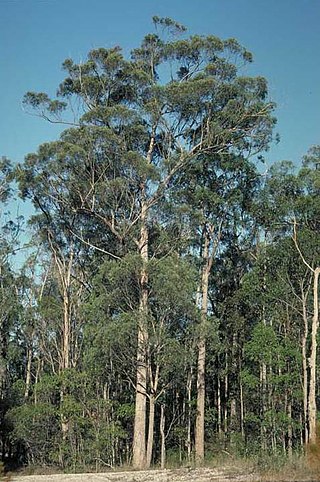
Eucalyptus carnea, known as the thick-leaved mahogany or broad-leaved white mahogany, is a species of tree that is endemic to coastal areas of eastern Australia. It has rough, stringy bark from the trunk to the thinnest branches, lance-shaped or curved adult leaves, flower buds in groups of between seven and eleven, white flowers and cup-shaped to hemispherical fruit.

Eucalyptus sphaerocarpa, commonly known as the Blackdown stringybark, is a species of tall forest tree that is endemic to Queensland. It has rough, stringy bark on the trunk and branches, lance-shaped to curved adult leaves, flower buds in groups of seven, nine or eleven, white flowers and shortened spherical fruit.
Eucalyptus aurifodina, commonly known as the small-leaved brown stringybark is a rare small tree that is endemic to the goldfields area of Victoria. It has rough, stringy bark on its trunk and branches, glossy green elliptic to egg-shaped adult leaves, oval or slightly club-shaped buds arranged in groups of seven to eleven, white flowers and hemispherical fruit.
